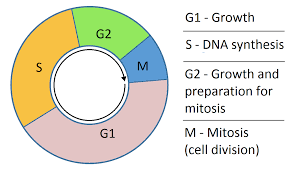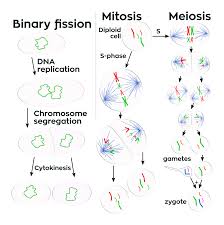CELL CYCLE AND CELL DIVISION
1. Identify the correct statement with regard to G1 phase (Gap 1) of interphase. [NEET 2020]
(1) Reorganization of all cell components takes place.
(2) Cell is metabolically active, grows but does not replicate its DNA.
(3) Nuclear Division takes place.
(4) DNA synthesis or replication takes place.
2. The fruit fly has 8 chromosomes (2n) in each cell. During interphase of Mitosis if the number of chromosomes at G1 phase is 8, what would be the number of chromosomes after S phase? [NEET 2021]
(1) 32 (2) 8
(3) 16 (4) 4
3. Which of the following stages of meiosis involves division of centromere? [NEET 2021]
(1) Telophase II (2) Metaphase I
(3) Metaphase II (4) Anaphase II
4. The centriole undergoes duplication during:- [NEET 2021]
(1) G2 phase (2) S-phase
(3) Prophase (4) Metaphase
5. Match List- I with List-II
List-I List-II
(a) S Phase (I) Proteins are synthesized
(b) G2 Phase (ii) Inactive phase
(c) Quiescent stage (iii) Interval between mitosis and initiation of DNA replication
(d) G1 phase (iv) DNA replication
Choose the correct answer from the options from below. [NEET 2021]
(a) (b) (c) (d)
(1) (ii) (iv) (iii) (i)
(2) (iii) (ii) (i) (iv)
(3) (iv) (ii) (iii) (i)
(4) (iv) (i) (ii) (iii)
6. Which stage of meiotic prophase shows terminalisation of chiasmata as its distinctive feature? [NEET 2021]
(1) Pachytene (2) Leptotene
(3) Zygotene (4) Diakinesis
7. In a mitotic cycle, the correct sequence of phases is [NEET 2020]
(1) G1, G2, S, M (2) S G1, G2, M
(3) G1, S, G2, M (4) M, G1, G2, S
8. Dissolution of the synaptonemal complex occurs during [NEET 2020]
(1) Zygotene (2) Diplotene
(3) Leptotene (4) Pachytene
9. Match the following with respect to meiosis [NEET 2020]
(a) Zygotene (i) Terminalization
(b) Pachytene (ii) Chiasmata
(c) Diplotene (iii) Crossing over
(d) Diakinesis (iv) Synapsis
Select the correct option from the following
(a) (b) (c) (d)
(1) (iv) (iii) (ii) (i)
(2) (i) (ii) (iv) (iii)
(3) (ii) (iv) (iii) (i)
(4) (iii) (iv) (i) (ii)
10 Some dividing cells exit the cell cycle and enter vegetative stage. this is called quiescent stage (G0). This process occurs at the end of [NEET 2020]
(1) G1 phase (2) S phase
(3) G2 phase (4) M phase
11. Match the following events that occurs in their respective phases of cell cycle and select the correct option:- [NEET 2020]
(1) G1 phase (i) Cell grows and organelle duplication
(b) S phase (ii) DNA replication and chromosome duplication
(c) G2 phase (iii) Cytoplasmic growth
(d) Metephase in M phase (iv) Alignment of chromosomes
(1) (a)-(i), (b)-(ii), (c)-(iii), (d)-(iv)
(2) (a)-(ii), (b)-(iii), (c)-(iv), (d)-(i)
(3) (a)-(iii), (b)-(iv), (c)-(i), (d)-(ii)
(4) (a)-(iv), (b)-(i), (c)-(ii), (d)-(iii)
12. Attachment of spindle fibres to kinetochores of chromosomes becomes evident in [NEET 2020]
(1) Metaphase (2) Anaphase
(3) Telophase (4) Prophase
13. During meiosis I, in which stage synapsis takes place? [NEET 2020]
(1) Leptotene (2) Pachytene
(3) Zygotene (4) Diplotene
14. Which of the following options gives the correct sequence of events during mitosis? [NEET 2017]
(1) Condensation – nuclear membrane – disassembly – crossing over- segregation- telophase
(2) Condensation- nuclear membrane disassembly- arrangement at equator- centromere division- segregation- telophase
(3) Condensation- crossing over – nuclear membrane disassembly- segregation- telophase
(4) Condensation- Arrangement at equator- centromere division- segregation- telophase
15. Crossing over takes place between which chromatids and in which stage of the cell cycle? [NEET 2019]
(1) Non-sister chromatids of non-homologous chromosomes at pachytene stage of prophase I
(2) Non-sister chromatids of non-homologous chromosomes at Zygotene stage of prophase I
(3) Non-sister chromatids of homologous chromosomes at pachytene stage of prophase I
(4) Non-sister chromatids of homologous chromosomes at Zygotne stage of prophase I
16. After meiosis I, the resultant daughter cell have [NEET 2019]
(1) Four times the amount of DNA in comprison to haploid gamete
(2) Same amount of DNA as in the parent cell in S phase
(3) Twice the amount of DNA in comparison to haploid
(4) Same amount of DNA in comparison to haploid gamete
17. The correct sequence of phases of cell cycle is [NEET 2019]
(1) M- G1– G2 -S (2) G1– G2— S- M
(3) S-G1-G2-M (4) G1– S- G2– M
18. The stage during which separationof the paired homologous chromosomes begins is [NEET 2016]
(1) Pachytene (2) Diplotene
(3) Zygotene (4) Diakinesis
19. In meiosis crossing over is initiated at [NEET 2016]
(1) Diplotene (2) Pachytene
(3) Leptotene (4) Zygotene
20. Match the stages of meiosis of Column-I their characteristic feature in Column-II and select the correct option using the codes given below:-
Column-I Column-II
a. Pachytene (i) Pairing of homologous chromosomes
b. Meta phase I (ii) Terminalisation of chiasmata
c. Diakinesis (iii) Crossing-over takes place
d. Zygotene (iv) Chromosomes align at equatorial plate
[NEET 2016]
(1) (a)-(iii), (b)-(iv), (c)-(ii), (d)-(i) (2) (a)-(i), (b)-(iv), (c)-(ii), (d)-(iii)
(3) (a)-(ii), (b)-(iv), (c)-(iii), (d)-(i) (4) (a)-(iv), (b)-(iii), (c)-(ii), (d)-(i)
21. Spindle fibres attach on to [NEET 2016]
(1) Diplotene (2) Pachytene
(3) Leptotene (4) Zygotene
22. During cell growth, DNA synthesis takes place in [NEET 2016]
(1) S phase (2) G1 phase
(3) G2 phase (4) M phase
23. Anaphase promoting complex (APC) is a protein degradation machinery necessary for proper mitosis of animal cells. If APC is defective in a human cell, which of the following is expected to occur? [NEET 2017]
(1) Chromosomes will not condense
(2) Chromosomes will will be fragmented
(3) Chromosomes will not segregated
(4) Recombination of chromosome arms will occur.
24. When cell has stalled DNA replication, fork, which checkpoint should be predominantly activated?
[NEET 2016]
25. Which of the following is not a characteristic feature during mitosis in somatic cells? [NEET 2016]
(1) Synapsis (2) Spindle fibres
(3) Disappearance of nucleolus (4) Chromosome movement
26. The complex formed by a pair of synapsed homologous chromosomes is called [NEET 2013]
(1) Kinetochore (2) Bivalent
(3) Axoneme (4) Equatorial plate
27. Meiosis takes place in:- [NEET 2013]
(1) Conidia (2) Gemmule
(3) Megaspore (4) Meiocyte
28. Mitotic spindle is mainly composed of which protein?
(1) Actin (2) Myosin (3) Tubulin (4) Myoglobin
29. Best material for the study of mitosis in laboratory is
(1) Anther (2) Root tip (3) Leaf tip (4) Ovary
30. The term “Meiosis” was given by
(1) A Flemming (2) Farmer and Moore (3) Johansen (4) Knoll and Ruska
31. If you are provided with root- tips of onion in your class and are asked to count the chromosomes, Which of the following stages can you most conveniently look into?
(1) Metaphase (2) Telophase (3) Anaphase (4) Prophase
32. What will be DNA amount in meiotic II products if DNA is 20 picogram in meiocyte at G2 -stage?
(1) 5 pg (2) 10 pg (3) 20 pg (4) 40 pg
33. If a diploid cell is treated with colchicine then it becomes
(1) Triploid (2) Tetraploid (3) Diploid (4) Monoploid
34. Which of the following structure will not be common to mitotic cell of a higher plant
(1) Centriole (2) Spindle fibre (3) Cell plate (4) Centromere.
35. Spindle fibre unite with which structure of chromosomes?
(1) Chromocentre (2) Chromomere
(3) Kinetochore (4) Centriole
36. A bacterium divides every 35 minutes. If a culture containing 105 cells per ml is grown for 175 minutes, What will be the cell concentration per ml after 175 minutes?
(1) 35 X 105 cells (2) 32 X 105 cells
(3) 175 X 105 cells (4) 85 X 105 cells
37. Crossing over that results in genetic recombination in higher organisms occurs between
(1) Sister chromatids of a bivalent (2) Non-sister chromatids of a bivalent
(3) Two daughter nuclei (4) Two different bivalents
38. Centromere is required for
(1) transcription (2) Crossing over
(3) Cytoplasmic cleavage (4) Movement of chromosomes torwards poles
39. Synapsis occurs between
(1) mRNA and ribosomes (2) Spindle fibres and centromere
(3) Two homologous chromosomes (4) A male and a female gamete
40. At what stage of the cell cycle are histone proteins synthesized in aeukaryotic cell?
(1) During entire prophase (2) During telophase
(3) During S-phase (4) During G2 stage of prophase.
ANSWER
1.(2) 2. (2) 3. (4) 4. (2) 5. (4) 6. (4) 7. (3) 8. (2) 9. (1) 10.(1)
11. (1) 12. (1) 13. (3) 14. (2) 15. (3) 16. (3) 17. (4) 18. (2) 19. (2) 20. (1)
21. (3) 22. (1) 23. (3) 24. (1) 25. (1) 26. (2) 27. (4) 28. (3) 29. (2) 30.(2)
31. (1) 32. (1) 33. (2) 34. (1) 35. (3) 36. (2) 37. (2) 38. (4) 39. (3) 40.(3)
QUOTE:- “SUCCESS IS ONLY MEANINGFUL AND ENJOYABLE IF IT FEELS LIKE YOUR OWN”


Your bio study blog is a breeze to read! It explains things in simple terms that anyone can understand. Can’t wait to learn more from your future posts!”